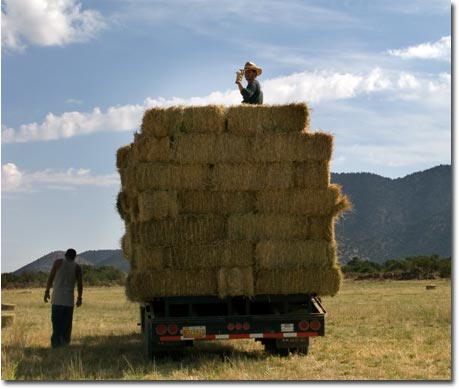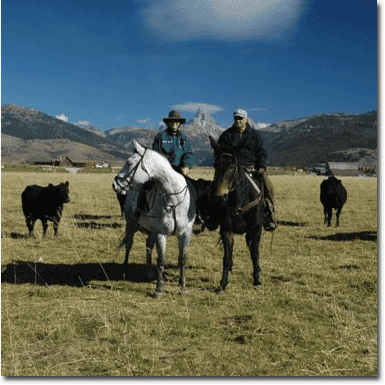A Breed Apart: Vassar and the Ranching Life
Writer Wallace Stegner called the American West — with its expansive landscapes, abundant natural resources, and the can-do spirit of its settlers — our “native home of hope.” Ranching has symbolized this romantic view since the cattle industry moved west in the 1800s, but as suburbs sprawl, grasses die, drillers loom, and the livestock industry’s economics shift, many ranchers are losing hope. Mary Lloyd Estrin ’66, who owns a ranch in New Mexico, says that the math is nearly impossible. “Droughts last decades, and price-per-pound seems to stay the same while fuel, hay, and feed costs keep going up,” she says. “The economics are tough — they’re simply not in the small ranch’s favor.”
Ranchers throughout the West are selling to developers or ravaging their lands in desperate attempts to survive economically. But some, like Estrin, are hanging on to hope by experimenting with innovative land-use practices, launching new business endeavors, or officially protecting their land through conservation easements.
Tania Goss Evans ’59 says she and her husband wouldn’t have bought their Idaho ranch two decades ago had they known how much the cattle industry and Western landscape would change. “However, our family and grandchildren love [the ranch], and that is enough for us to continue,” she says. “The greatest loss to the country is the evaporation of the land that defines so much of our West.”
Helen Kleberg Groves ’49 was raised on King Ranch, the birthplace of Texas ranching. Groves’s great-grandfather, steamboat captain Richard King, purchased 15,500 acres along the Gulf Coast of south Texas from the holders of what was once a Spanish land grant. King was impressed by the Santa Gertrudis Creek, which ran through the property, nourishing a wide variety of wildlife in the desert. He was sure that cattle could flourish there, too. They did. The first domestic breed of cattle registered in America — the rust-colored Santa Gertrudis — was developed at King Ranch.

Groves’s family kept King Ranch going through droughts and depressions by diversifying assets: leasing oil and gas rights to a company that would become ExxonMobil, developing stronger grasses and mineral supplements to boost cows’ health, and partly shifting focus from cows to horses. Many of America’s top quarter horses and thoroughbreds have come through King Ranch’s breeding programs. The ranch also draws income from managed commercial hunting trips, albeit those that follow strict rules to conserve the ranch’s wildlife.
Hunting and ranching often go hand in hand. Neighboring the King Ranch is the Armstrong Ranch, now infamous for hosting Vice President Dick Cheney’s hunting-trip-gone-wrong in 2007. Tobin and Anne Legendre Armstrong ’49 regularly entertained the Texas political elite, including both George Bushes, James Baker III, and Karl Rove, with hunting trips on their 50,000-acre ranch settled by Tobin’s grandfather. Tobin ran a prominent cattle industry association for nearly five decades, while Anne held high-level positions in the Nixon and Ford Administrations, and later advised Reagan and George H. W. Bush on foreign intelligence. Anne, who passed away this past August [see Letters, page 2], met Tobin while visiting friend and Vassar classmate Groves at King Ranch.

Northwest of the King and Armstrong Ranches, at the headwaters of the Devils River, lives a smaller-scale rancher facing perhaps more typical twenty-first-century ranching challenges. Claudia Abbey Ball ’52 inherited her family’s ranch and is still working to maintain the business — and the land — to pass on to her descendants. When Ball took over the business, the ranch had suffered from years of droughts, overgrazing, and dwindling profits. She knew she needed to change her methods of ranching and diversify the ranch’s streams of income. “It’s next to impossible to make a profit as a rancher these days, but I’ve certainly tried,” she says. “Some people can do it.”
Ball first refocused her ranching efforts on sheep and goats (as her grandfather had done), reducing her cattle herd by about 75 percent. “My father loved cattle, but this is sheep and goat country after all,” she says. Ball also switched out her cattle stock for the dependable Beefmaster breed, which is better suited to the region’s dry climate. She also began experimenting with holistic management techniques such as rotational grazing, a process that improves pastures by allowing the grasses time to rest. Ball took courses in sustainable management and still looks for new ways to improve her natural resources — and profits.
The Hudspeth River Ranch does not bring in any mineral or oil revenues, but because Ball has taken such good care of her land, she has been able to raise substantial income by leasing managed-fishing and commercial-hunting rights. “The Devils River is the last pure river in Texas because we, and other ranchers around the headwaters, have ranched responsibly to keep the river clean,” she says. “This makes it very attractive to fishermen and has allowed me to take the recreational route.”
Ball says more ranchers are taking an active stake in the health of their natural resources. “The long drought years got many ranchers’ attention, and they’re much more environmentally responsible now,” she says. “They understand that they won’t survive if they don’t take care of what they’ve got.”

Like Ball, Kit Sherry Strang ’56 and her husband had to diversify their 500-acre ranch near Aspen, Colorado, in order to survive economically. As cattle ranching became less economically viable, the Strangs turned to their sod farm and equestrian business for support. But an influx of population and development in the area meant that ranches in the Aspen Valley began selling for enormously high sums on the open market.
The Strang family, however, decided to protect their ranch rather than sell it, donating much of their land to a conservation easement with the Aspen Valley Land Trust. Land trusts are private, nonprofit organizations that aim to conserve at-risk lands, generally by putting together land easements — private, voluntary, binding agreements placed in perpetuity with landowners — and monitoring their restrictions over time. There are 37 million acres preserved in 1,667 land trusts throughout the United States — and the American West is the fastest growing region in number of acres saved, according to the Land Trust Alliance. For many ranchers, easements have become better options in recent years as the federal government, and some states, have sweetened tax incentives connected to easements — often lowering estate taxes and real-estate tax valuations, and increasing deductions for working ranches.
Strang says that beefed-up tax credits in Colorado have led many “old-time families in the area — families whose grandfathers homesteaded the land and whose descendants are still farming and ranching” — to place easements on their land. Easement terms vary, but usually allow ranchers and their descendents to continue working their land if they follow sustainability rules and permanently restrict development. Some easements permit the sale of land, as long as future buyers agree to all restrictions.
The Strangs’ easement allows them to continue ranching their land in a “responsible and sustainable manner,” and the Aspen Valley Land Trust is obligated to visit the ranch annually to ensure that the Strangs (or whoever owns the land in the future) are “living up to the terms of the easement and that no new structures have been built on the eased land,” Strang explains. The family has designated five plots of land, which are not part of the easement, as house lots for their children and ranch manager. They are also allowed to build certain structures, such as corrals and barns, around the ranch headquarters. “It takes a connection to and love of the land to go the conservation easement route,” Strang says.
Because they are placed in perpetuity, land-trust agreements are a big decision for most families — and not everyone is fond of them. “I’m violently opposed to conservation easements,” says Claudia Abbey Ball ’52. “It’s not fair to the next generation to tie up land in perpetuity, no matter how desperate times feel. And many of the organizations that hold the trusts are a mess.” But Tania Goss Evans ’59, who was once president of the Jackson Hole Land Trust, says that land trusts are the best option for most ranchers. “With land prices escalating out of sight, very few families can afford to pay death taxes, resulting in sales to developers — and so much of ranches’ open space contains major wildlife habitat as well as stunning views, which are compromised with all the development,” she says. “The only way I see to control such growth on these pristine lands is through the protection of conservation easements.” Evans and her family have worked with a local land trust to place an easement on their ranch. But because all of the ranches that once surrounded their property have been sold to developers and turned into housing developments, their ranch’s “scenic and habitat advantages” have diminished, and it’s no longer a priority for protection.

They’re still in an investment period with Wagyu, but the Estrins are pleased. Though difficult and expensive to breed, Wagyu cows adapt well to hot, dry climates. And because the breeding process is so precise, the Estrins must keep their cows close to headquarters to keep an eye on them, which means that much of their land is now greener. The land nearest headquarters is kept as healthy as possible through a grazing method that rotates cattle quickly enough so that they never chew down grass to the ground, Estrin says. Their cattle is also garnering heavy interest in the marketplace: the Estrins successfully held North America’s first pure-Wagyu auction last April.
Although their land — and bottom line — are looking stronger, Lone Mountain Ranch continues to face threats: Santa Fe and Albuquerque sprawls are encroaching, and because landowners in New Mexico do not hold mineral rights to their land, the Estrins have to legally fend off miners, and probably soon, methane gas drillers. In the ’90s, the Estrins placed the mountains surrounding their ranch — which were the most likely to be developed or mined — into a conservation easement. They’re now considering doing the same for more of their land.
What is a natural resource worth? Wallace Stegner once asked. His answer: “Anything it costs.” But that’s a tough calculus for a rancher facing threats on multiple fronts: legal, environmental, economic. “You just don’t know how small ranches make it anymore,” says Estrin. Her concern applies to the Estrins’ own ranch as it does to any other. And as the methane gas drilling moves ever closer, the Estrins are gearing up for another battle to save the ranch.
-Veronika Ruff ’01
Veronika Ruff has written about food, nutrition, and the environment for Self, Men's Health, Budget Travel, the Minneapolis Star Tribune,and the Associated Press.
